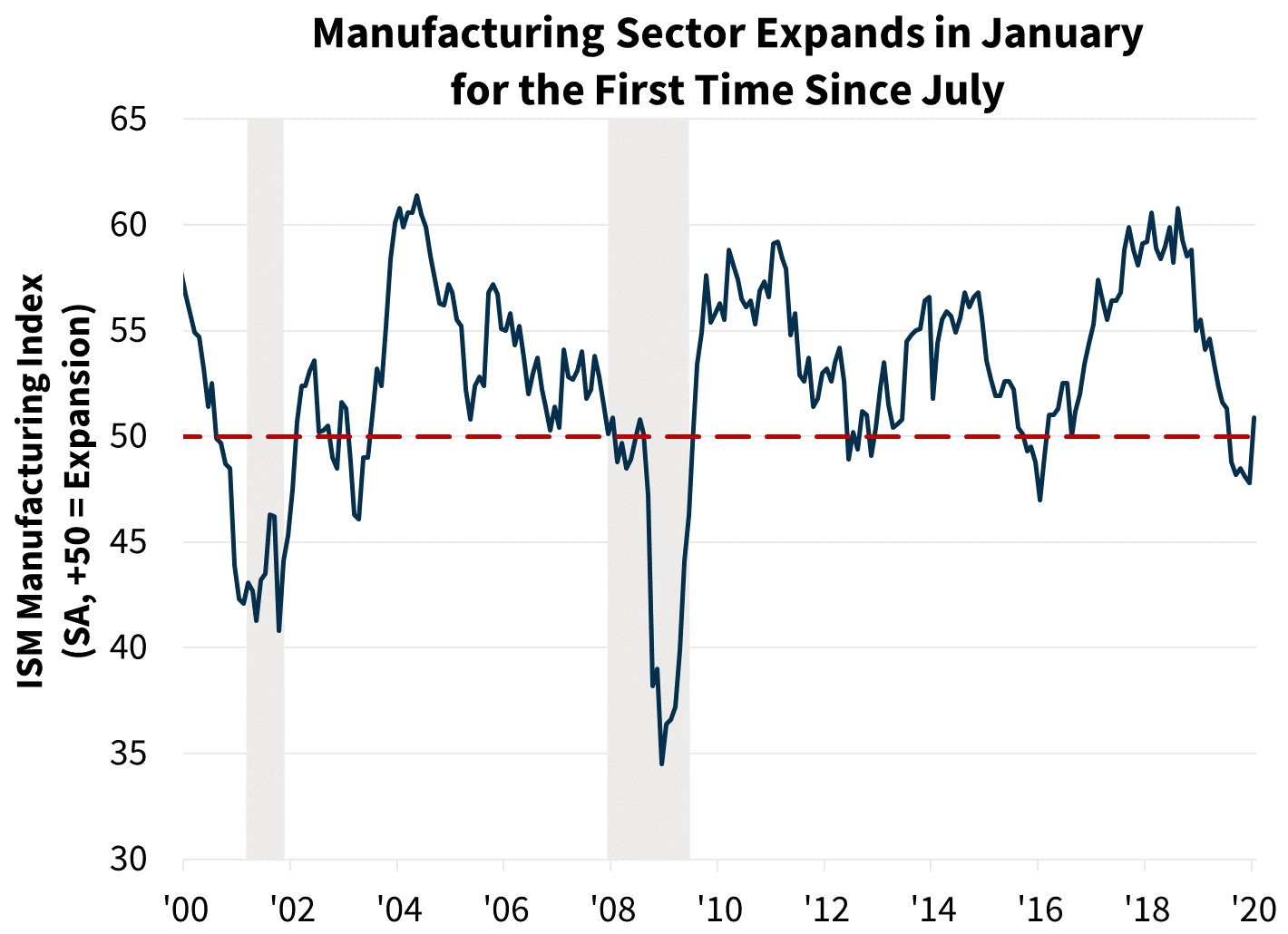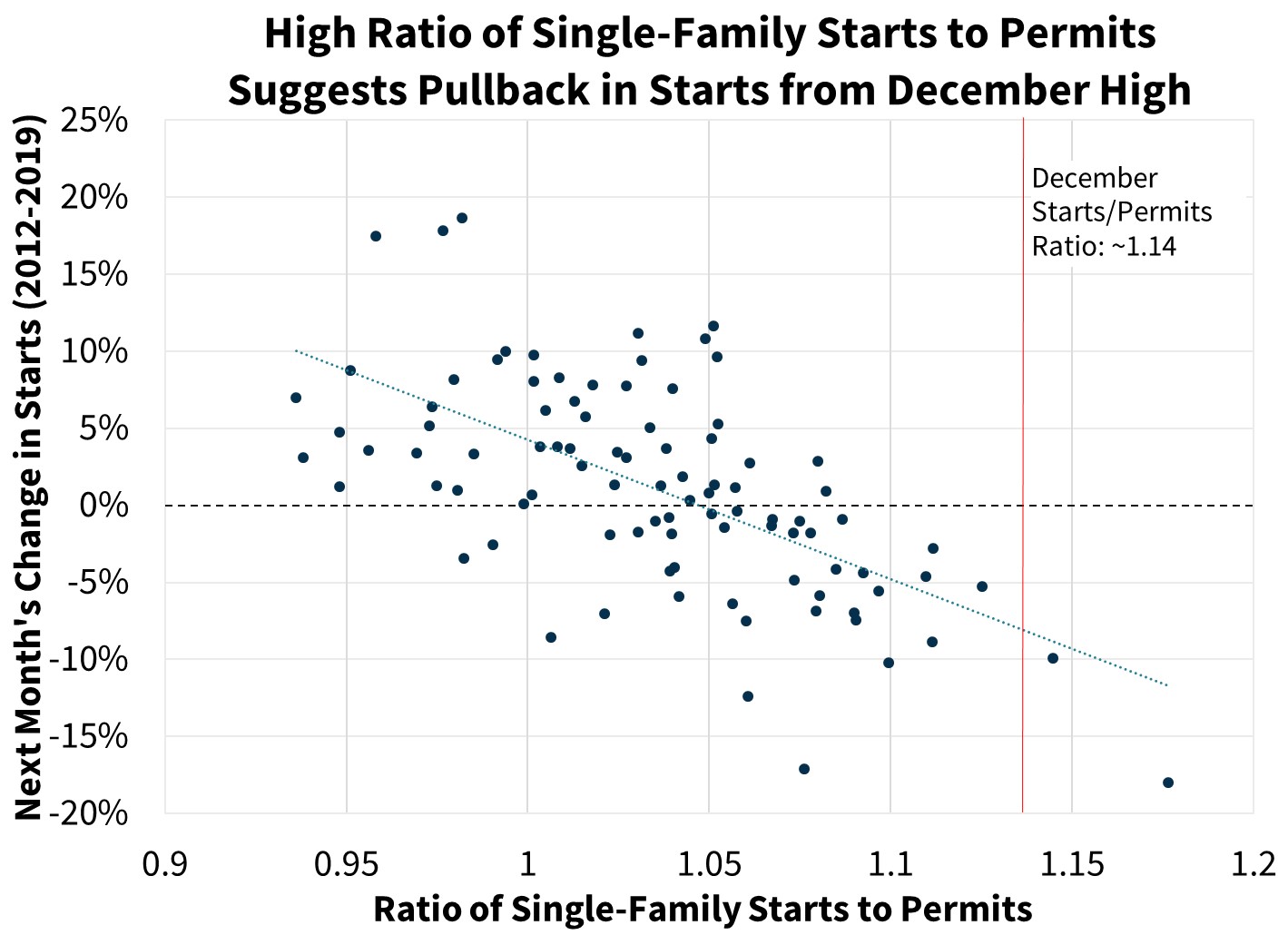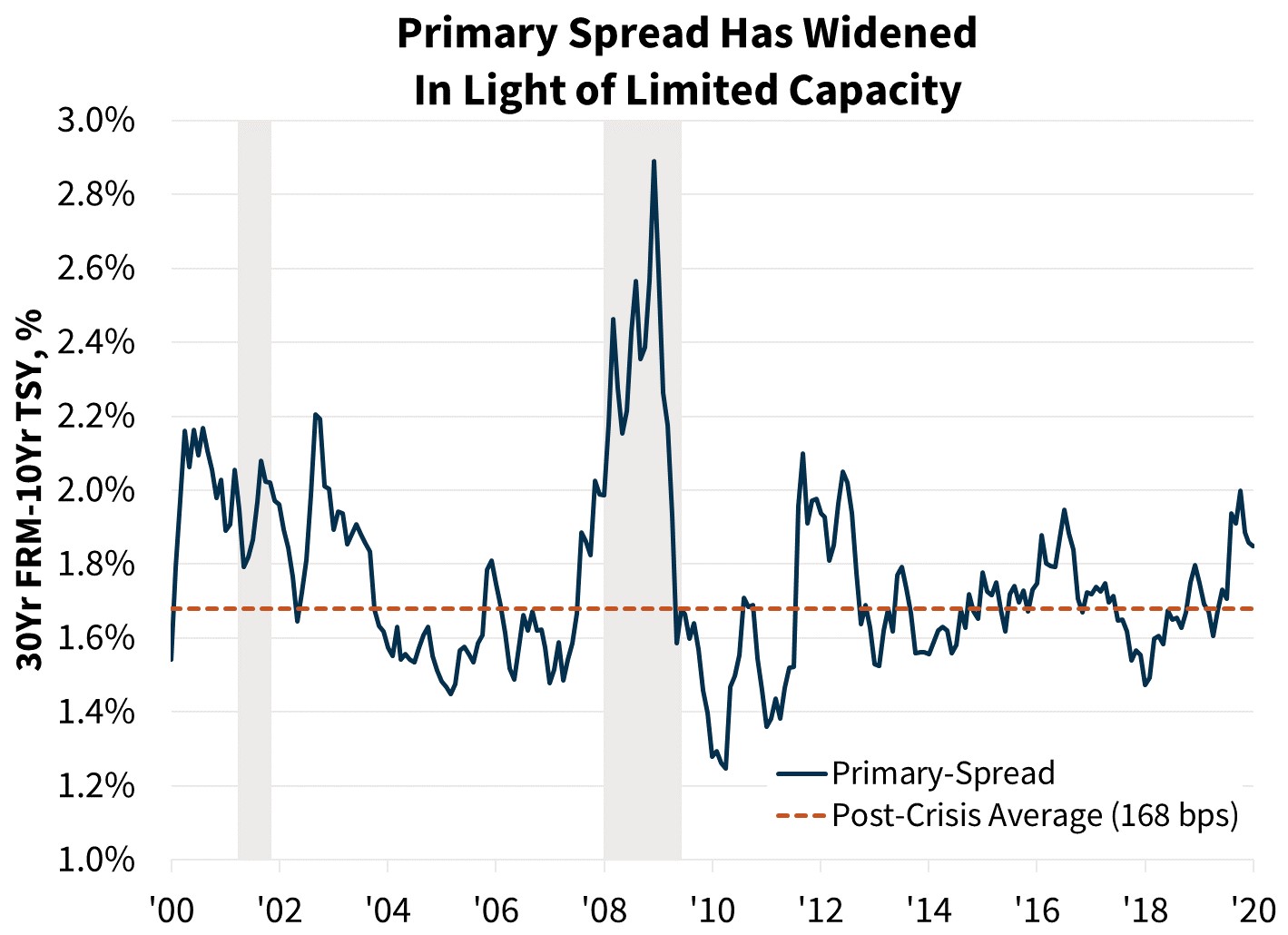Housing Builds on Resilient Labor Markets and Consumers
Our view that the housing market will be a primary beneficiary in 2020 from the U.S. economy’s resilience received a major boost this month as continued gloom regarding Boeing and the new coronavirus failed to dent strong growth in labor markets and single-family housing construction. Our updated forecast for the macroeconomy reflects a significant upgrade to business fixed investment (BFI) in the second half of this year and beyond, which contributed to a one-tenth improvement in our top-line growth expectations for both full-year 2020 and 2021 to 2.2 percent and 2.1 percent, respectively. Meanwhile, our updated housing market forecast shows greater expected strength in essentially every part of the housing market extending through the first half of 2021.
We adjusted our forecast for growth in real gross domestic product (GDP) in the first quarter of this year to an annualized rate of 1.9 percent, down from 2.3 percent. This reflected no change in our view of underlying growth; rather, earlier-than-expected growth in government spending and housing construction pulled forward activity that would otherwise have occurred in Q1, and we expect abnormal growth in net exports over the fourth quarter to be reversed. Our forecast for Q2 GDP growth remained at 2.0 percent, but our expectation for quarterly growth in the second half of 2020 strengthened considerably due largely to our expectation of a recovery in BFI and net exports as Boeing resumes production and deliveries of its previously grounded 737 MAX planes.
The risks to our forecast remain skewed to the downside. The extent and severity of both the Boeing situation and the coronavirus outbreak remain uncertain. Election year policy uncertainty could lead to volatility in financial markets. Continued earnings growth diminishes short-term concerns regarding equity and bond asset values, but the possibility of price corrections remains a key concern. Any of these risks could derail the expected recovery in BFI and, if severe enough, could also cause labor markets and/or consumer spending to falter. Upside risks include a reversal of the modest increase in the savings rate over the past year, fueling stronger than expected consumption, and the possibility that monetary stimulus programs applied by central banks in several countries will revive global economic growth more quickly than our baseline assumptions.
Employment Report Supports View of Continued Consumer Spending
We believe any concerns caused by the slightly disappointing December employment report were solidly dispelled by the January employment report. Growth in nonfarm payrolls beat consensus estimates at a healthy 225,000 for January and an equally healthy three-month moving average of 211,000. A slight uptick in the unemployment rate was entirely accounted for by a healthy increase in the labor force participation rate, with the prime-age participation rate rising to its highest level since September 2008, marking a complete recovery from the economic downturn. The report also confirmed support for growth in consumer spending, with the year-over-year increase in average hourly earnings rising to 3.1 percent along with upward revisions to previously reported data. More than 20,000 new jobs were created in residential construction (including specialty contractors), the largest gain in a year, consistent with recent strength in housing starts and continued homebuilder confidence.

The manufacturing sector continued to show weakness in the employment report, with payrolls contracting by 12,000, but other indicators support our view that the manufacturing slowdown may have reached its bottom. The Federal Reserve reported that the manufacturing component of industrial production increased by 0.2 percent in December, the second straight month of improvement, and the latest Institute for Supply Management (ISM) manufacturing survey showed activity jumped 3.1 percentage points to 50.9 in January, marking the largest increase in more than six years and the first month of expansion (>50) since last July. The ISM survey showed strong contributions from new orders, production, and new export orders, and the employment component, while indicating contraction, showed a strong increase from its previous level.
Problems at manufacturing giant Boeing continue to drag on the overall economy. We now believe that production of the grounded 737 MAX aircraft will not resume until June, with recertification and deliveries beginning again in July. The further delays will have wide-ranging effects on suppliers, passenger airlines, and employees, but our forecast had already incorporated most of these effects: the primary effect of our updated analysis is to shift our forecast of the timing of an eventual recovery in BFI. We now expect BFI to grow at annualized rates of just 0.3 percent in Q1 and 2.1 percent in Q2, both down significantly from our previous forecasts of 2.0 and 4.0 percent; on the other hand, we expect the succeeding quarters to be quite a bit stronger with BFI growing at annualized rates of 7.1 percent in Q3 and 6.2 percent in Q4, compared with our previous forecasts of 2.9 percent and 2.7 percent. We also expect a more pronounced drawdown in business inventories after the resumption of deliveries in the third and fourth quarters, as well as more pronounced growth in net exports.
Our forecast for resilient consumer spending, the key driver for near-term GDP growth, has not materially changed. The first estimate of Q4 personal consumption expenditures was 1.8 percent annualized, a slowdown from Q3, but we expect a rebound in the first quarter to 2.6 percent, supported by solid wage growth. The Bureau of Economic Analysis reported that wage and salary compensation grew at a healthy annualized rate of 4.3 percent in Q4, extending the upward trend to three quarters. While overall disposable personal income growth was slow compared to recent quarters, the aggregate number was pulled down by weak interest and dividend income, as well as a decline in farm subsidies that we do not expect to continue into 2020.
The Fed, with an Eye on Weak Inflation, Expected to Remain on Hold
The statement released following the January meeting of the Federal Open Market Committee (FOMC), and Chairman Powell’s remarks at the post-meeting press conference, reflected a small but definitely dovish shift in language indicating that the FOMC wants to see inflation “return” to its 2.0 percent symmetric target. The PCE price index rose by just 1.6 percent in December from a year earlier, and our forecast for 2020 PCE inflation is flat from 2019 at 1.5 percent. The risk of a further cut in the federal funds rate clearly continues to outweigh the risk of an increase, but in the absence of further signs of weakening we maintain our view that the FOMC will hold the federal funds target rate in its current band of 1.5 percent to 1.75 percent through the forecast period.
Housing Will Continue to Benefit from Labor Market Strength and Low Interest Rates

Our previous forecast included strengthening December housing activity but jumps in new construction and existing home sales over the month exceeded our expectations. We believe the end-of-year paces were unsustainable and expect some pullback in coming months. Still, we maintain our view of solid housing activity adding to overall economic growth this year, with full-year real residential fixed investment growing 3.9 percent after contracting 0.1 percent in 2019.

Housing starts surged 16.9 percent in December to an annualized pace of 1.61 million, the fastest since 2006, driven by both single-family and multifamily construction. The data were likely inflated by unseasonably warm weather as well as potential difficulties in making seasonal adjustments over the holiday season, so the magnitude should be interpreted with caution. Single-family permits, which tend to be less volatile than starts, grew only 0.8 percent in the same period, suggesting that the underlying construction trend is strengthening more modestly than implied by starts. Throughout this expansion, when the ratio of starts to permits reached a level near what occurred in December, starts have always pulled back meaningfully in the following month. While we have modestly increased our forecast for single-family starts in 2020, with the quarterly average pace hitting 1 million annualized units by the end of the year, we expect a significant decline in January from the December pace, leading to a slight drop in the first quarter.
Multifamily housing starts also surged in December, rising 29.8 percent to a pace of 553,000 annualized units, the fastest since 1986. As was the case with single-family starts, this was well above expectations, but the series is especially volatile month to month. In contrast, multifamily building permits fell 11.0 percent following two months of solid increases. While demand for multifamily housing remains strong, we believe a significant pullback in starts is likely over the coming months. For the year, we believe low interest rates, solid job growth, and continued household formation among younger cohorts will continue to support multifamily housing construction at a pace similar to recent years. Our forecast for multifamily starts in 2020 has increased from 385,000 to 403,000. For more on multifamily market conditions please see the February 2020 Multifamily Market Commentary.
Sales of new homes dipped slightly in December by 0.4 percent to an annualized pace of 694,000 units, with net negative revisions to previously reported data. The pace of new home sales remained strong over much of 2019 as builders drew down inventories that had grown following the late 2018 sales slowdown. With the months’ supply of new homes for sale now back near the recent historic norm of 5.4 months, further growth in new home sales will be constrained by the pace of construction activity. While the surge in starts in December is likely to lead to a pickup in new sales over the next few months, we forecast relatively flat new home sales following this increase until higher construction activity can be sustained later in the year.
Sales of existing homes ended the year more strongly than expected, rising 3.6 percent in December to 5.54 million annualized units, the fastest pace since February 2018. As with starts, this pace seems unsustainable as the inventories of existing homes for sale continued to tighten: the months’ supply of existing homes for sale at the current sales pace fell to just 3.0 months, a record low since the series began in 1999. Moreover, the December Pending Sales Index, which leads existing home sales by about 45 days on average, plunged 5.3 points in December to the lowest level since February 2019, suggesting a pullback to begin the year. We have therefore increased our forecast of existing sales for the first quarter only slightly, and we expect modest declines in the quarterly pace for much of this year. On the other hand, the increase in Fannie Mae’s Home Purchase Sentiment Index® (HPSI) by 1.3 points in January to a level near its all-time high was driven by increases in the shares both of respondents who believe this is a good time to purchase houses and of respondents who believe this is a good time to sell. If an increasing number of owners of existing homes offer homes for sale, inventory growth could lead us to increase our forecast for existing home sales.
Lower Mortgage Rates Fuel Refi Originations
The average 30-year fixed mortgage rate fell 10 basis points in January to 3.62 percent, according to Freddie Mac, and then further to 3.45 percent in the first week of February, which, if maintained for the month, would be the lowest level since August 2016. The recent decline in mortgage rates has helped drive a surge in refinance applications, which jumped 33 percent in January according to the Mortgage Bankers Association. We expect February activity to be similarly strong.

While we believe Treasury rates will rise as coronavirus-related worries recede, it is likely that growth in the 30-year mortgage rate will be comparatively subdued. The jump in refinance applications has pushed mortgage lenders’ production capacity closer to its limits. The primary spread between mortgage rates and the 10-year Treasury rate is now nearly 20 basis points higher than the business-cycle average, reflecting increased lender pricing power as refinance demand exceeds capacity. Once refinance demand slows lenders are likely to reduce rates to compete for volume, narrowing the primary spread; thus, the current low mortgage rates may be maintained in coming months even if the 10-year Treasury rises modestly.
The tight supply of homes for sale combined with lower mortgage rates continues to bolster home prices. The S&P CoreLogic Case-Shiller National House Price Index rose 3.5 percent in November from a year prior, the fastest annual pace since April 2019, and the December CoreLogic National House Price Index was up 4.0 percent from a year prior, an acceleration from 3.5 percent in November. The continued increase in home prices will encourage new construction but will partially offset the affordability gain from lower mortgage rates. On the other hand, the Federal Reserve Board’s Senior Loan Officer Opinion Survey for the three months ending in January reported a small net share of banks loosening standards for both GSE-eligible and government loans after tightening slightly in the prior quarter. This modest reversal accompanied strong credit performance: The Mortgage Bankers Association reported that the 30-plus day delinquency rate for all outstanding mortgages fell further in the fourth quarter to 3.8 percent, the lowest since 1972, driven primarily by conventional loans as delinquency rates for Federal Housing Administration (FHA) loans ticked up slightly.
Taken as a whole, we have revised upward our forecast for total mortgage originations in 2020 from $2.06 trillion to $2.28 trillion. Our forecast for refinance originations increased sharply from $690 billion to $895 billion, while our purchase originations forecast increased much more modestly to $1.39 trillion. Incoming actuals increased our 2019 estimate by $134 billion to $2.32 trillion, so our total originations forecast for 2021, which changed only slightly to $2.00 trillion, represents our expectation of two straight years of slowing origination volume.
Economic & Strategic Research (ESR) Group
February 11, 2020
For a snapshot of macroeconomic and housing data between the monthly forecasts, please read ESR's Economic and Housing Weekly Notes.
Data source for charts: Institute for Supply Management, Census Bureau, Freddie Mac, Federal Reserve, Fannie Mae ESR Group.
Opinions, analyses, estimates, forecasts and other views of Fannie Mae's Economic & Strategic Research (ESR) Group included in these materials should not be construed as indicating Fannie Mae's business prospects or expected results, are based on a number of assumptions, and are subject to change without notice. How this information affects Fannie Mae will depend on many factors. Although the ESR group bases its opinions, analyses, estimates, forecasts and other views on information it considers reliable, it does not guarantee that the information provided in these materials is accurate, current or suitable for any particular purpose. Changes in the assumptions or the information underlying these views could produce materially different results. The analyses, opinions, estimates, forecasts and other views published by the ESR group represent the views of that group as of the date indicated and do not necessarily represent the views of Fannie Mae or its management.
ESR Macroeconomic Forecast Team
- Doug Duncan, SVP and Chief Economist
- Brad Case, Director
- Nick Embrey, Economist
- Richard Goyette, Business Analyst
- Mark Palim, VP and Deputy Chief Economist
- Eric Brescia, Economist
- Rebecca Meeker, Financial Economist
